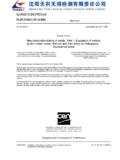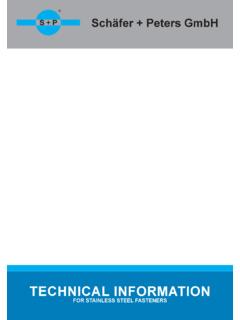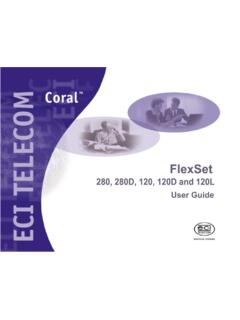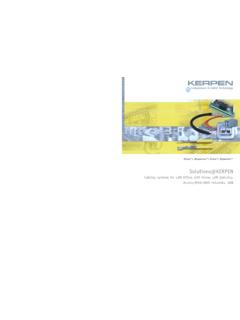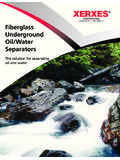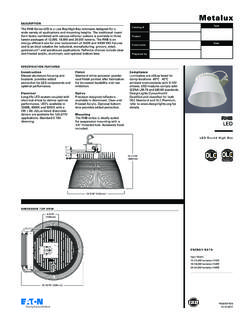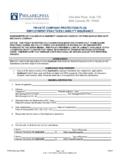Transcription of Standard Practice for Magnetic Particle Examination
1 Designation: E 1444 94aAn American National StandardStandard Practice forMagnetic Particle Examination1 This Standard is issued under the fixed designation E 1444; the number immediately following the designation indicates the year oforiginal adoption or, in the case of revision, the year of last revision. A number in parentheses indicates the year of last reapproval. Asuperscript epsilon (e) indicates an editorial change since the last revision or specification has been approved for use by agencies of the Department of This Practice establishes minimum requirements formagnetic Particle Examination used for the detection of surfaceor slightly subsurface discontinuities in ferromagnetic Practice is intended as a direct replacement of MIL-STD-1949. Guide E 709 can be used in conjunction with thispractice as a The Magnetic Particle Examination method is used todetect cracks, laps, seams, inclusions, and other discontinuitieson or near the surface of ferromagnetic materials.
2 Magneticparticle Examination may be applied to raw material, billets,finished and semifinished materials, welds, and in-serviceparts. Magnetic Particle Examination is not applicable tononferromagnetic metals and alloys such as austenitic Standard does not purport to address all of thesafety concerns, if any, associated with its use. It is theresponsibility of the user of this Standard to establish appro-priate safety and health practices and determine the applica-bility of regulatory limitations prior to Referenced The following documents form a part of this standardpractice to the extent specified standards :A 275/A 275M Test Method for Magnetic Particle Exami-nation of Steel Forgings2A 456 Specification for Magnetic Particle Inspection ofLarge Crankshaft Forgings2D 96 Test Methods for Water and Sediment in Crude Oil bythe Centrifuge Method (Field Procedure)3E 543 Practice for Evaluating Agencies that Perform Non-destructive Testing4E 709 Guide for Magnetic Particle Examination4E 1316 Terminology for Nondestructive Document:SNT-TC-1A Recommended Practice and Supplement Mag-netic Particle of Automotive Engineers (SAE)-AMS Docu-ments.
3 6 AMS 2300 Premium Aircraft-Quality Steel CleanlinessMagnetic Particle Inspection Procedure7 AMS 2301 Aircraft Quality Steel Cleanliness Magnetic Par-ticle Inspection Procedure7 AMS 2303 Aircraft Quality Steel Cleanliness MartensiticCorrosion Resistant Steels Magnetic Particle InspectionProcedure7 AMS 2641 Magnetic Particle Inspection Vehicle7 AMS 3040 Magnetic particles , Nonfluorescent, DryMethod7 AMS 3041 Magnetic particles , Nonfluorescent, WetMethod, Oil Vehicle, Ready-To-Use7 AMS 3042 Magnetic particles , Nonfluorescent, WetMethod, Dry Powder7 AMS 3043 Magnetic particles , Nonfluorescent, WetMethod, Oil Vehicle, Aerosol Packaged7 AMS 3044 Magnetic particles , Fluorescent, Wet Method,Dry Powder7 AMS 3045 Magnetic particles , Fluorescent, Wet Method,Oil Vehicle, Ready-To-Use7 AMS 3046 Magnetic particles , Fluorescent, Wet Method,Oil Vehicle, Aerosol Packaged7 AMS 5355 Investment standards :6 FED-STD-313 Material Safety Data Sheets, Preparationand the Submission of8 FED-STD-595 standards :6 MIL-STD-1907 Inspection, Liquid Penetrant and MagneticParticle Soundness Requirements for Materials, Parts, andWeldments81 This Practice is under the jurisdiction of ASTM Committee E-7 on Nonde-structive Testing and is the direct responsibility of Subcommittee on LiquidPenetrant and Magnetic Particle edition approved Nov.
4 15, 1994. Published January 1995. Originallypublished as E 1444 91. Last previous edition E 1444 Book of ASTM standards , Vol Book of ASTM standards , Vol Book of ASTM standards , Vol from American Society for Nondestructive Testing, 1711 ArlingatePlaza, Box 28518, Columbus, OH of standards , specifications, drawings, and publications required bymanufacturers in connection with specification acquisition should be obtained fromthe contracting activity or as directed by the contracting from Society of Automotive Engineers, 400 Commonwealth Drive,Warrendale, PA from Standardization Documents Order Desk, Bldg. 4 Section D, 700 Robbins Ave., Philadelphia, PA 19111-5094, Attn: ASTM, 100 Barr Harbor Drive, West Conshohocken, PA 19428-2959, United Nondestructive Testing Personnel Qualifica-tion and Certification8 MIL-STD-1949 Magnetic Particle Inspection, Method of8 MIL-STD-2175 Castings, Classification and Inspection of8 MIL-STD-45662 Calibration Systems RequirementsMIL-I-83387 Inspection Process, Magnetic Rubber8 DoD-F-87935 Fluid, Magnetic Particle Inspection, Suspen-sion (Metric) Document.
5 929 CFR Hazard Contracts Unless otherwise specified, the edi-tions of the documents that are DoD adopted are those listed inthe issue of the DoDISS (Department of Defense Index ofSpecifications and standards ) cited in the of Precedence In the event of conflict betweenthe text of this Practice and the referenced documents citedherein, the text of this Practice takes The definitions relating to Magnetic par-ticle Examination , which appear in Terminology E 1316, shallapply to the terms used in this of Terms Specific to This current (ac) an electrical current thatreverses its direction of flow at regular light the visible light level measured at thespecimen surface with the black light(s) agency a prime contractor, subcontrac-tor, or government agency procuring Magnetic Particle inspec-tion (G) the unit of flux density or induction in thecgs electromagnetic unit system (1 G510 4 Tesla (T); in air,1 G is equivalent to 1 oersted (Oe), which equals A/m).
6 Shot the production of circular magnetizationby passing current directly through the part being inspected, orcentral conductor, while being held in contact with the headstocks in a horizontal wet flux a conceptualization of the magneticfield intensity based on the line pattern produced when ironfilings are sprinkled on paper laid over a permanent Magnetic field lies in the direction of the flux lines and hasan intensity proportional to the line the process by which the elementarymagnetic domains of a material are predominantly aligned inone the ability of a material to retain magne-tism after the magnetizing force has been Significance and Magnetic Particle Examination consists of magnetizingthe area to be inspected, applying suitably prepared magneticparticles while the area is magnetized, and subsequentlyinterpreting and evaluating any resulting Particle accumula-tions. Maximum detectability occurs when the discontinuity ispositioned perpendicular to the Magnetic flux.
7 In order todetect discontinuities in all directions, at least two magneticfields, perpendicular to one another in a plane parallel to thesurface being inspected, shall be used, except when specificallyexempted by the contracting General Requirements The acceptance require-ments applicable to the part or group of parts shall beincorporated as part of the written procedure either specificallyor by reference to other applicable documents, such as MIL-STD-1907, containing the necessary information. Applicabledrawings or other documents shall specify the acceptance sizeand concentration of discontinuities for the component, withzoning of unique areas as required by design acceptance requirements shall be as approved on or asspecified by the contracting agency. Methods for establishingacceptance requirements for large crankshaft forgings arecovered in Specification A 456. Methods for establishingrequirements for steel forgings are covered in Test MethodA 275/A 275M.
8 Methods for classifying metal castings aregiven in MIL-STD-2175 and AMS 5355. MIL-STD-1907 pro-vides a classification scheme for ferromagnetic forgings, cast-ings, extrusions, and Steel Cleanliness The examinationof aircraft-quality steel for cleanliness using Magnetic particleexamination shall be as specified in AMS 2300, 2301, or 2303as appropriate to the type of steel being inspected. However,inspection of parts fabricated from this material shall be inaccordance with the requirements of this Qualification Personnel performing exami-nations in accordance with this Practice shall be qualified andcertified in accordance with ASNT Personnel QualificationSNT-TC-1A or MIL-STD-410 for military purposes, or asspecified in the contract or purchase Qualification The agency performing the test-ing or Examination shall meet, as a minimum, the requirementsof Practice E Procedure Magnetic Particle examinationshall be performed in accordance with a written procedureapplicable to the parts or group of parts under testing.
9 Theprocedure shall be in accordance with the requirements andguidelines of this Practice . The procedure shall be capable ofdetecting the smallest rejectable discontinuities specified in theacceptance requirements. The written procedure may be gen-eral if it clearly applies to all of the specified parts being testedand meets the requirements of this Practice . All writtenprocedures shall be approved by an individual qualified andcertified at Level III for Magnetic Particle Examination inaccordance with Procedures shall be submitted to thecontracting agency when of the Written Procedure The written pro-cedure shall include at least the following elements, eitherdirectly or by reference to the applicable Procedure identification number and the date it waswritten; Identification of the parts to which the procedure9 Available from Superintendent of Documents, Government PrintingOffice, Washington, 14442applies; this shall include the material and alloy of which theparts are fabricated; Sequence of Magnetic Particle Examination as re-lated to manufacturing process operation, if applicable; Identification of test parts used for system perfor-mance verification (see and ).
10 Areas of the part to be examined (include anillustration either sketch or photo); Part preparation required before testing; Directions for positioning the item with respect tothe magnetizing equipment; The type of magnetizing current and the equipmentto be used; Method of establishing the magnetization (head,coil, prods, yoke, cable wrap, etc.); Directions of magnetization to be used, the order inwhich they are applied, and any demagnetization procedures tobe used between shots; The current level, or the number of ampere turns, tobe used and the duration of its application; Type of Magnetic Particle material (dry or wet,visible or fluorescent, etc.) to be used and the method andequipment to be used for its application and, for the case of wetparticles, the Particle concentration limits; Type of records and method of marking parts afterexamination; Acceptance requirements, to be used for evaluatingindications and disposition of parts after evaluation; Postinspection demagnetization and cleaning Sequence When Magnetic Particle ex-amination is specified, it shall be performed after the comple-tion of operations that could cause surface or near-surfacedefects.


